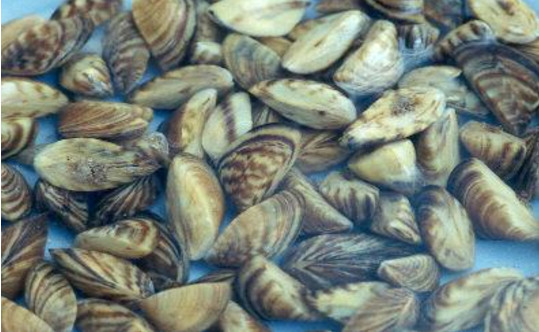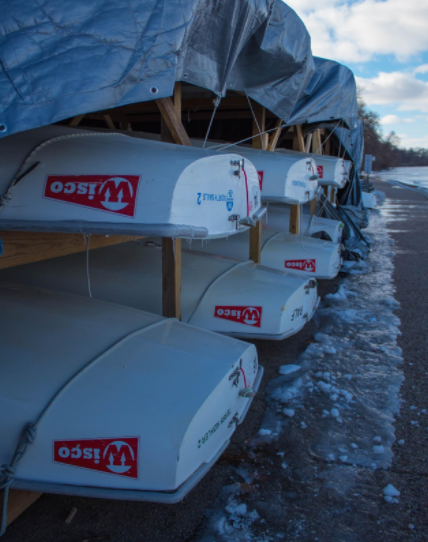






In medicine, early detection can make or break your recovery from an illness. MRI technology helps us find muscle tissue damage and internal bleeding. CAT scans can help us find tumors fast enough to begin cancer treatment.
Just as infections can spread throughout the body, an infection can also spread across a landscape. The equivalent of an ecosystem-sized pathogen is an invasive species. But when it comes to invasive zebra mussels infesting local lakes, early warning systems are not enough.
Once a lake is infected, there is no cure – and three lakes in Madison are facing this problem.
What are zebra mussels?
Zebra mussels are originally from Europe and were transported in ships entering the Great Lakes for commerce in the 19th century.
Fully grown, zebra mussels are small, hard-shelled mollusks that travel from inland lake to inland lake functioning like a virus. Once infected, the lake water can infect any other lake it contacts. As there is no solution to zebra mussels, the spreading can be devastating for ecosystems at large as their lakes are stripped of natural processes by these invasive species.
 Four lakes and one river in Dane County now have zebra mussels, according to the DNR.
Four lakes and one river in Dane County now have zebra mussels, according to the DNR.
According to the US Geologic Survey, the mussels can inhabit the pipes of water systems and industrial facilities and negatively impact farms. Continued colonization by mussels can even weaken steel structures, a serious concern of engineers investigating the structural integrity of bridges.
In lakes, the mussels outcompete native animals for nutrients and can wipe out populations of other freshwater species. Like tumors, they take over and spread until the host has either no nutrients or no space left to grow into.
The situation in Madison
According to DNR research, 299 lakes and rivers in Wisconsin have zebra mussels inhabiting their waters. In Dane County, the infected lakes include Wingra, Koshkonong, Mendota and Monona as well as the Wisconsin River. The ranges of the population sizes vary.
In lakes Monona and Mendota, the mussels are multiplying rapidly, studies from the University of Wisconsin Center for Limnology show.
The mollusks lay hidden in Madison’s lakes, rarely showing their black-and- tan-striped backs or causing any obvious damage. According to Michael Spear, a researcher at UW–Madison, small populations are usually passed over until erupting to the point of causing ecological disruptions.
The population in Madison’s lakes is growing and will soon produce negative byproducts.
“Their population size has increased pretty dramatically since the fall of 2015 to early summer of 2016 and to early fall 2016,” Spear said.
Spear specializes in invasive species ecology, and a rare discovery afforded him an opportunity to further the research done on the zebra mussel invasive species ecology.
“Just by chance, one of the undergraduate classes was having a lab on Lake Mendota and they pulled out a piece of trash out of the Lake and saw a Zebra Mussel on it,” Spear said. “When we went and investigated the rest of the Lake we noticed them at very low densities, which is unusual.”
 Mussels can travel from lake to lake by attaching themselves to boats. (Mason Muerhoff/Madison Commons)
Mussels can travel from lake to lake by attaching themselves to boats. (Mason Muerhoff/Madison Commons)
The low number of zebra mussels in Monona and Mendota suggests the populations are still very young and were introduced into the lakes recently.
Once established, the mussels will function as a filter system, taking all the nutrients floating in the water and concentrating them at the bottom of the lake where the mussels comfortably situate themselves on any hard material that their bodies are capable of attaching to.
From there, the mussels eat what they can, and the rest concentrates into algal mats, which is the classic pond scum. The thick, smelly mats can rise to the tops of lakes and tangle boats, enswathe swimming beaches and create pungent odors that plague homeowners.
In Lake Wingra, the mussels have not caught on. Though they are listed as observed on the DNR website, so far no significant populations have been located. Tyler Leeper, the neighborhood association head for the Dudgeon Monroe Neighborhood along the lakefront of Lake Wingra, has not heard any complaints regarding the mussels.
“We have not seen or heard of anyone finding them, and they have not been a problem,” Leeper said. “Yet.”
Controlling an epidemic
Currently, the Wisconsin Department of Natural Resources classifies zebra mussels as a restricted species under Wisconsin’s Invasive Species Rule, NR 40. This makes the transportation or possession of the species illegal, with specific exceptions including academic purposes. Often times, however, the transportation of the mussels is by accident, creating unique challenges for reducing their spread and when raising awareness.
“It’s a real mix. Those that are more in tune with the lakes or the natural resources have some inkling of what an invasive species is and what the negative consequences are. Others often times aren’t aware of it,” said Peter Jopke of the Dane County Land & Water Conservation Department.
The mussels travel in a similar fashion from lake to lake, attaching themselves to boats, trailers or other rigid materials. They can also be transported in their microscopic life stages in water kept in bilges, live wells or any other water storage containers. Once the infected water or individuals reach a new body of water, the reproductive process begins again.
Once established, an invasive species is extremely difficult to remove.
“You take a lake the size of Mendota and any kind of manual effort to remove Zebra Mussels is just not practical at all,” Spear said.
Chemical solutions can cause problems with other populations in the lake and is frowned upon by homeowners with lakeside property as it affects the recreational activity that the local economy depends on.
According to the DNR’s website, boaters should take care to remove plant material from props, trailers and equipment, clean off boat hulls before transporting them from lake to lake and continue to observe the lakes for any signs of infection.
Though their characteristics make them easily comparable to a disease, in many cases zebra mussels are more similar to a death sentence. Ravaging local ecologies and halting natural processes, the mussels are too resilient, too comfortable in their new homes. No methods are proven to permanently terminate them.
Madison’s lakes provide a valuable glimpse into the lifecycle of the zebra mussel, and provide new information on how their destructive momentum is built. But the seeds are sown, and the clock is ticking.
“Prevention is far and away and consistently the best strategy to curb the problem of invasive species,” Spear said.
|
|
|
Welcome to the Madison Commons, a website designed to provide news and information about all of Madison's neighborhoods and a crossroads for the discussion of community issues. The name comes from the idea of a village commons, a place for news, talk, debate, and some entertainment, too, that's open to everyone.
All rights reserved. Read more about the Madison Commons and its partners.

